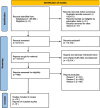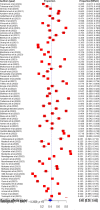Vaccine hesitancy in context of COVID-19 in East Africa: systematic review and meta-analysis
- PMID: 39395943
- PMCID: PMC11470748
- DOI: 10.1186/s12889-024-20324-z
Vaccine hesitancy in context of COVID-19 in East Africa: systematic review and meta-analysis
Abstract
Background: The outbreak of the SARS-CoV-2 pandemic has had a significant impact on human lives, and the development of effective vaccines has been a promising solution to bring an end to the pandemic. However, the success of a vaccination program heavily relies on a significant portion of the population being vaccinated. Recent studies have indicated a rise in vaccine hesitancy over time and inconsistent factors affecting it. This study aimed to synthesis of the pooled prevalence of COVID-19 vaccine hesitancy and associated factors among various communities in East Africa.
Methods: The review encompassed relevant descriptive and observational studies conducted between January 1, 2020, and December 26, 2023. We browsed various databases, including PubMed, Google Scholar, Scopus, African online Journal, cross-references, and Web of Science. After extracted and exported to R the data analysis was performed using R version 4.2. Meta-package were used to estimate the pooled prevalence and factors of vaccine hesitancy. Publication bias was assessed through funnel plots, Egger's test, and trim-and-fill methods.
Results: After carefully screening an initial pool of 53,984 studies, a total of 79 studies were included in this systematic review and meta-analysis. The overall pooled prevalence of vaccine hesitancy was 40.40% (95% CI: 35.89%; 45.47%, I2: 99.5%). Identified factors influencing vaccine hesitance were female sex, under 40 years old, inadequate prevention practices, relying on web/internet as a source of information, having a negative attitude towards the vaccine, uncertainty about vaccine safety, fear of adverse effects, uncertainty about contracting COVID-19, and belief in conspiracy myths.
Conclusions: Approximately four out of ten individuals in this region express hesitancy towards vaccination. A tailored approach that considers the socio-demographic context could significantly reduce this hesitancy. To achieve high vaccination coverage, a comprehensive strategy is essential, necessitating substantial social, scientific, and health efforts. The success of vaccination campaigns within this population relies on the widespread and consistent implementation of effective interventions.
Registration: Registered in PROSPERO with ID: CRD42024501415.
Keywords: COVID-91; East Africa; Hesitancy; SARS-COV-19; Vaccine.
© 2024. The Author(s).
Conflict of interest statement
The authors declare that have no competing interest.
Figures
Similar articles
-
Determinants of COVID-19 vaccine acceptance and hesitancy among adolescents and youths aged 10-35 years in sub-Saharan African countries: A systematic review and meta-analysis.PLoS One. 2024 Oct 7;19(10):e0310827. doi: 10.1371/journal.pone.0310827. eCollection 2024. PLoS One. 2024. PMID: 39374213 Free PMC article.
-
COVID-19 vaccine acceptance and hesitancy in Cameroon: a systematic review and meta-analysis.BMC Public Health. 2025 Mar 17;25(1):1035. doi: 10.1186/s12889-025-22195-4. BMC Public Health. 2025. PMID: 40097975 Free PMC article.
-
COVID- 19 vaccine uptake and its determinants in Cameroon: a systematic review and meta-analysis (2021-2024).BMC Infect Dis. 2025 Apr 15;25(1):525. doi: 10.1186/s12879-025-10946-y. BMC Infect Dis. 2025. PMID: 40234831 Free PMC article.
-
COVID-19 Vaccine Hesitancy Among People Living with HIV: A Systematic Review and Meta-Analysis.AIDS Behav. 2024 Jul;28(7):2183-2192. doi: 10.1007/s10461-024-04344-9. Epub 2024 Apr 16. AIDS Behav. 2024. PMID: 38625625
-
Role of Individual, Social and Health Factors as Determinants of COVID-19 Vaccine Hesitancy: Results from the Second Phase of the Italian EPICOVID19 Web-Based Survey.Int J Environ Res Public Health. 2025 Feb 19;22(2):314. doi: 10.3390/ijerph22020314. Int J Environ Res Public Health. 2025. PMID: 40003539 Free PMC article.
Cited by
-
Community readiness and acceptance for the implementation of the malaria vaccine among caretakers of at-risk children in sub-Saharan Africa: a systematic review and meta-analysis.Malar J. 2025 Aug 12;24(1):259. doi: 10.1186/s12936-025-05384-9. Malar J. 2025. PMID: 40797258 Free PMC article.
References
-
- World Health Organization. WHO Director-General's opening remarks at the media briefing on COVID-19 - 11 March 2020. 2020 [cited 2024 January 1]. Available from: https://www.who.int/directorgeneral/speeches/detail/who-director-general....
-
- World Health Organization. WHO Declares Public Health Emergency for Novel Coronavirus. 2020 [cited 2024 January 1]. Available from: https://www.medscape.com/viewarticle/924596.
-
- Baye, K., COVID-19 prevention measures in Ethiopia: current realities and prospects. Intl Food Policy Res Inst. 2020:141
-
- World health organization. Achieving 70% COVID-19 Immunization Coverage by Mid-2022. 23 December 2021; Available from: https://www.who.int/news/item/23-12-2021-achieving-70-covid-19-immunizat.... Cited 07 Aug 2024.
Publication types
MeSH terms
Substances
LinkOut - more resources
Full Text Sources
Medical
Miscellaneous



